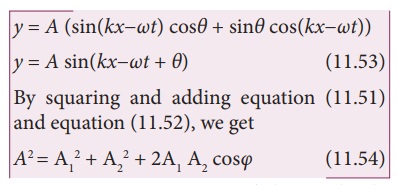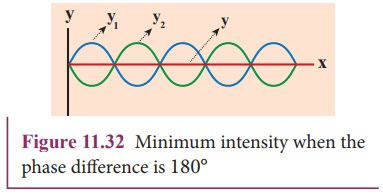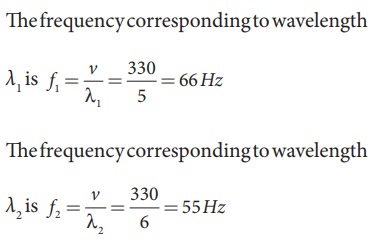Chapter: 11th Physics : UNIT 11 : Waves
Waves Superposition Principle
SUPERPOSITION
PRINCIPLE
When
a jerk is given to a stretched string which is tied at one end, a wave pulse is
produced and the pulse travels along the string. Suppose two persons holding
the stretched string on either side give a jerk simultaneously, then these two
wave pulses move towards each other, meet at some point and move away from each
other with their original identity. Their behaviour is very different only at
the crossing/meeting points; this behaviour depends on whether the two pulses
have the same or different shape as shown in Figure 11.26.

When
the pulses have the same shape, at the crossing, the total displacement is the
algebraic sum of their individual displacements and hence its net amplitude is
higher than the amplitudes of the individual pulses. Whereas, if the two pulses
have same amplitude but shapes are 180° out of phase at the crossing point, the
net amplitude vanishes at that point and the pulses will recover their identities
after crossing. Only waves can possess such a peculiar property and it is
called superposition of waves. This
means that the principle of superposition explains the net behaviour of the
waves when they overlap. Generalizing to any number of waves i.e, if two are
more waves in a medium move simultaneously, when they overlap, their total
displacement is the vector sum of the individual displacements. We know that
the waves satisfy the wave equation which is a linear second order homogeneous
partial differential equation in both space coordinates and time. Hence, their
linear combination (often called as linear superposition of waves) will also
satisfy the same differential equation.
To
understand mathematically, let us consider two functions which characterize the
displacement of the waves, for example,
y1 = A1 sin(kx
− ωt)
and
y2 = A2 cos(kx
− ωt)
Since,
both y1 and y2 satisfy the wave equation
(solutions of wave equation) then their algebraic sum
y = y1 +
y2
also satisfies the wave equation. This means, the displacements are additive. Suppose we multiply y1 and y2 with some constant then their amplitude is scaled by that constant
Further,
if C1 and C2 are used to multiply the
displacements y1 and y2, respectively, then, their
net displacement y is
![]()
![]() y = C1 y1 + C2 y2
y = C1 y1 + C2 y2
This
can be generalized to any number of waves. In the case of n such waves in more
than one dimension the displacements are written using vector notation.
Here,
the net displacement

The
principle of superposition can explain the following :
(a)
Space (or spatial) Interference (also known as Interference)
(b)
Time (or Temporal) Interference (also known as Beats)
(c)
Concept of stationary waves
Waves
that obey principle of superposition are called linear waves (amplitude is much
smaller than their wavelengths). In general, if the amplitude of the wave is
not small then they are called non-linear waves. These violate the linear
superposition principle, e.g. laser. In this chapter, we will focus our
attention only on linear waves.
We
will discuss the following in different subsections:
Interference of waves

Interference is a phenomenon in which two waves superimpose to form a resultant
wave of greater, lower or the same amplitude.

Consider
two harmonic waves having identical frequencies, constant phase difference φ and same wave form (can be treated as
coherent source), but having amplitudes A1
and A2, then

Suppose
they move simultaneously in a particular direction, then interference occurs
(i.e., overlap of these two waves). Mathematically

Therefore,
substituting equation (11.47) and equation (11.48) in equation (11.49), we get
y = A1 sin(kx −
ωt) + A2 sin(kx −
ωt + φ)
Using
trigonometric identity sin (α+β) = (sin α
cosβ + cosα sinβ ), we get
y = A1 sin(kx
− ωt)+A2 [sin(kx −
ωt) cosφ + cos(kx − ωt) sinφ]

then
equation (11.50) can be rewritten as y = A sin(kx−ωt) cosθ +
A cos(kx−ωt) sinθ

Since,
intensity is square of the amplitude (I = A2),
we have

This
means the resultant intensity at any point depends on the phase difference at
that point.
(a) For constructive interference:
When
crests of one wave overlap with crests of another wave, their amplitudes will
add up and we get constructive interference. The resultant wave has a larger
amplitude than the individual waves as shown in Figure 11.29 (a).
The
constructive interference at a point occurs if there is maximum intensity at
that point, which means that
cosφ = + 1 ⇒
φ = 0, 2π,4π,… = 2nπ,
where
n = 0,1,2,...
This
is the phase difference in which two waves overlap to give constructive
interference.
Therefore,
for this resultant wave,

Hence,
the resultant amplitude
A=
A1 + A2

(b) For destructive interference:
When
the trough of one wave overlaps with the crest of another wave, their
amplitudes “cancel” each other and we get destructive interference as shown in
Figure 11.29 (b). The resultant amplitude is nearly zero. The destructive
interference occurs if there is minimum intensity at that point, which means
cosφ = − 1 ⇒ φ = π,3π,5π,… = (2 n-1) π, where n = 0,1,2,…. i.e.
This is the phase difference in which two waves overlap to give destructive
interference. Therefore,

Hence,
the resultant amplitude
A=|A1−A2|
Let
us consider a simple instrument to demonstrate the interference of sound waves
as shown in Figure 11.30.

A
sound wave from a loudspeaker S is sent through the tube P. This looks like a
T-shaped junction. In this case, half of the sound energy is sent in one
direction and the remaining half is sent in the opposite direction. Therefore,
the sound waves that reach the receiver R can travel along either of two paths.
The distance covered by the sound wave along any path from the speaker to
receiver is called the path length . From the Figure 11.30, we notice that the
lower path length is fixed but the upper path length can be varied by sliding
the upper tube i.e., is varied. The difference in path length is known as path
difference,
![]()
![]() ∆r = |r2 − r1|
∆r = |r2 − r1|
Suppose
the path difference is allowed to be either zero or some integer (or integral)
multiple of wavelength λ.
Mathematically, we have
∆r = nλ where, n = 0, 1, 2, 3,....
Then
the two waves arriving from the paths r1 and
r2 reach the receiver
at any instant are in phase (the
phase difference is 0° or 2π) and
interfere constructively as shown in Figure 11.31.

Therefore,
in this case, maximum sound intensity is detected by the receiver. If the path
difference is some half-odd-integer (or half-integral) multiple of wavelength λ, mathematically, Δ r = n(λ/2)
where,
n = 1,3,... (n is odd)
then
the two waves arriving from the paths r1
and r2 and reaching the
receiver at any instant are out of phase (phase difference of π or 180°). They
interfere destructively as shown in Figure 11.32. They will cancel each other.

Therefore,
the amplitude is minimum or zero amplitude which means no sound. No sound
intensity is detected by the receiver in this case. The relation between path
difference and phase difference is

EXAMPLE 11.16
Consider
two sources A and B as shown in the figure below. Let the two sources emit
simple harmonic waves of same frequency but of different amplitudes, and both
are in phase (same phase). Let O be any point equidistant from A and B as shown
in the figure. Calculate the intensity at points O, Y and X. (X and Y’ are not
equidistant from A & B)

Solution
The
distance between OA and OB are the same and hence, the waves starting from A
and B reach O after covering equal distances (equal path lengths). Thus, the
path difference between two waves at O is zero.
OA −
OB = 0
Since
the waves are in the same phase, at the point O, the phase difference between
two waves is also zero. Thus, the resultant intensity at the point O is
maximum.
Consider
a point Y, such that the path difference between two waves is λ. Then the phase difference at Y is

Therefore,
at the point Y, the two waves from A and B are in phase, hence, the intensity
will be maximum.
Consider
a point X, and let the path difference the between two waves be λ/2.
Then
the phase difference at X is

Therefore,
at the point X, the waves meet and are in out of phase, Hence, due to
destructive interference, the intensity will be minimum.
EXAMPLE 11.17
Two
speakers C and E are placed 5 m apart and are driven by the same source. Let a
man stand at A which is 10 m away from the mid point O of C and E. The man
walks towards the point O which is at 1 m (parallel to OC) as shown in the
figure. He receives the first minimum in sound intensity at B. Then calculate
the frequency of the source.
(Assume
speed of sound = 343 m s-1)

Solution

The
first minimum occurs when the two waves reaching the point B are 180° (out of
phase). The path difference ∆x = λ/2.
In
order to calculate the path difference, we have to find the path lengths x1 and x2.
In
a right triangle BDC,

The
path difference ∆x = x2 − x1 = 10.6 m−10.1 m = 0.5 m. Required that this path
difference

Formation of beats
When
two or more waves superimpose each other with slightly different frequencies,
then a sound of periodically varying amplitude at a point is observed. This
phenomenon is known as beats. The number of amplitude maxima per second is
called beat frequency. If we have two sources, then their difference in
frequency gives the beat frequency.
Number
of beats per second
n
= | f1 - f2| per second

EXAMPLE 11.18
Consider
two sound waves with wavelengths 5 m
and 6 m. If these two waves propagate
in a gas with velocity 330 ms-1.
Calculate the number of beats per second.
Solution
Given
λ1 = 5m and λ2 = 6m
Velocity
of sound waves in a gas is v = 330 ms-1
The
relation between wavelength and velocity is v
= λf => f
=
v/λ

The
number of beats per second is
|
f1 − f2| = |66 − 55| = 11 beats per sec
EXAMPLE 11.19
Two
vibrating tuning forks produce waves whose equation is given by y1 = 5 sin(240π t) and y2 = 4 sin(244πt).
Compute the number of beats per second.
Solution
Given
y1 = 5 sin(240π t) and y2 = 4 sin(244πt)
Comparing
with y = A sin(2π f1t), we get
2πf1 = 240π ⇒ f1
= 120Hz
2πf2 = 244π ⇒ f2
= 122Hz
The
number of beats produced is | f1
− f2| = |120 − 122| = |−
2|=2 beats per sec
Related Topics